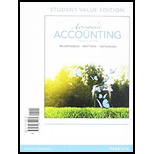
Manufacturing overhead allocation:
Manufacturing overhead cost is the pool of all indirect costs incurred for the production. These are the costs which are not directly traceable to the product.
Under/ over allocation of overhead:
The overheads are allocated using an overhead allocation rate which is calculated on the basis of estimated overhead costs and allocation bases. Hence there may be a difference in allocated overhead and actual overhead incurred. This difference gives birth to the under/ over allocation of overhead.
To indicate:
The difference between underallocated and overallocated overhead and the reason for each situation
Want to see the full answer?
Check out a sample textbook solution
Chapter 19 Solutions
Horngren's Accounting, Student Value Edition Plus MyAccountingLab with Pearson eText, Access Card Package
- Calculate the cost of goods sold.arrow_forwardMitchell's Home Furnishings made Net Sales Revenue of $180,000, and the Cost of Goods Sold (COGS) totaled $108,000. What is the gross profit percentage for this period? a. 50% b. 40% c. 30% d. 60% HELParrow_forwardGeneral accounting questionarrow_forward
- Correct solution and accountingarrow_forwardSims Inc. had a $195,000beginning balance in Accounts Receivable. During the year, credit sales totaled $820,000, and collections from customers amounted to $700,000. What was the net amount of receivables included in current assets at the end of the year, before any provision for doubtful accounts?arrow_forwardCompute the ending carrying value of the trade name for 2010 and 2011.arrow_forward

 AccountingAccountingISBN:9781337272094Author:WARREN, Carl S., Reeve, James M., Duchac, Jonathan E.Publisher:Cengage Learning,
AccountingAccountingISBN:9781337272094Author:WARREN, Carl S., Reeve, James M., Duchac, Jonathan E.Publisher:Cengage Learning, Accounting Information SystemsAccountingISBN:9781337619202Author:Hall, James A.Publisher:Cengage Learning,
Accounting Information SystemsAccountingISBN:9781337619202Author:Hall, James A.Publisher:Cengage Learning, Horngren's Cost Accounting: A Managerial Emphasis...AccountingISBN:9780134475585Author:Srikant M. Datar, Madhav V. RajanPublisher:PEARSON
Horngren's Cost Accounting: A Managerial Emphasis...AccountingISBN:9780134475585Author:Srikant M. Datar, Madhav V. RajanPublisher:PEARSON Intermediate AccountingAccountingISBN:9781259722660Author:J. David Spiceland, Mark W. Nelson, Wayne M ThomasPublisher:McGraw-Hill Education
Intermediate AccountingAccountingISBN:9781259722660Author:J. David Spiceland, Mark W. Nelson, Wayne M ThomasPublisher:McGraw-Hill Education Financial and Managerial AccountingAccountingISBN:9781259726705Author:John J Wild, Ken W. Shaw, Barbara Chiappetta Fundamental Accounting PrinciplesPublisher:McGraw-Hill Education
Financial and Managerial AccountingAccountingISBN:9781259726705Author:John J Wild, Ken W. Shaw, Barbara Chiappetta Fundamental Accounting PrinciplesPublisher:McGraw-Hill Education





